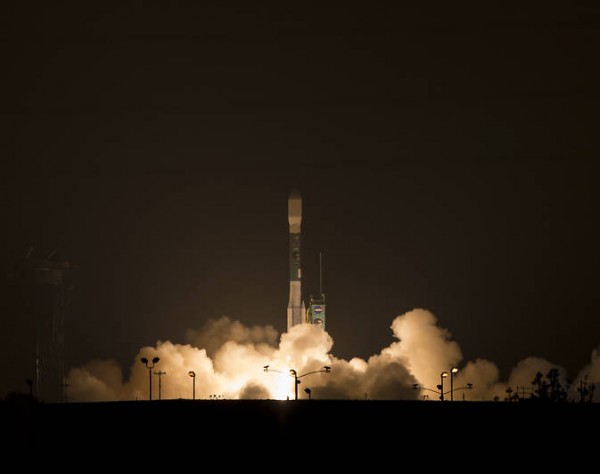NASA Successfully Launches Groundbreaking SMAP Satellite to Study Earth's Soil Moisture
| Ana Verayo | | Feb 01, 2015 05:23 AM EST |
(Photo : NASA/Bill Ingalls) SMAP is NASA’s first Earth-observing satellite designed to collect global observations of surface soil moisture and its freeze/thaw state.
A Delta 2 rocket was successfully launched Saturday carrying a NASA satellite that will measure soil moisture of the Earth's surface. The data the satellite obtains will be utilized for weather forecasting and tracking climate change.
Scientists believe soil moisture links all of Earth's ecological and biological systems. Data from the satellite will enable forecasters to find more effective ways of dealing with drought or flooding in different regions.
Like Us on Facebook
The rocket blasted-off at 9:22 A.M. EST from the Vandenberg Air Force Base in California. It was built by United Launch Alliance is a partnership of Lockheed Martin and Boeing corporations and measures 127 feet tall.
The launch was delayed for two days due to high winds and minor repairs to the rocket's insulation system. On top of the rocket is NASA's 2,100 pound SMAP (Soil Moisture Active Passive) satellite that will spend at least three years measuring the Earth's surface water to a depth of two inches in the soil.
Global soil moisture accounts for less than one percent of the Earth's total water reservoir. The rest of the 97 percent are found in the world's oceans and ice sheets, said Dara Entekhabi from MIT, who is also the lead scientist for NASA's SMAP observatory.
To date, scientists rely on computer simulations to estimate soil moisture. SMAP will use two microwave instruments to measure soil moisture as it orbits Earth from 426 miles above.
It will take every two to three days to collect new data that includes exact soil measurements from every point and area on the planet.
This data is pivotal not only for scientists to understand further climate change but also for weather forecasters, agriculture and water resource managers and even world policy makers. according to NASA deputy associate administrator Geoffery Yoder.
SMAP will join 19 other satellites in studying the planet's seas, land and atmosphere. SMAP will cost NASA US$916 million for this three year project. including the launch.
TagsNASA, SMAP, NASA SMAP launch satellite soil moisture Earth, NASA Successfully Launches Groundbreaking SMAP Satellite to Study Earth's Soil Moisture
©2015 Chinatopix All rights reserved. Do not reproduce without permission
EDITOR'S PICKS
-

Did the Trump administration just announce plans for a trade war with ‘hostile’ China and Russia?
-

US Senate passes Taiwan travel bill slammed by China
-

As Yan Sihong’s family grieves, here are other Chinese students who went missing abroad. Some have never been found
-

Beijing blasts Western critics who ‘smear China’ with the term sharp power
-

China Envoy Seeks to Defuse Tensions With U.S. as a Trade War Brews
-

Singapore's Deputy PM Provides Bitcoin Vote of Confidence Amid China's Blanket Bans
-

China warns investors over risks in overseas virtual currency trading
-

Chinese government most trustworthy: survey
-

Kashima Antlers On Course For Back-To-Back Titles
MOST POPULAR
LATEST NEWS
Zhou Yongkang: China's Former Security Chief Sentenced to Life in Prison

China's former Chief of the Ministry of Public Security, Zhou Yongkang, has been given a life sentence after he was found guilty of abusing his office, bribery and deliberately ... Full Article
TRENDING STORY

China Pork Prices Expected to Stabilize As The Supplies Recover

Elephone P9000 Smartphone is now on Sale on Amazon India

There's a Big Chance Cliffhangers Won't Still Be Resolved When Grey's Anatomy Season 13 Returns

Supreme Court Ruled on Samsung vs Apple Dispute for Patent Infringement

Microsoft Surface Pro 5 Rumors and Release Date: What is the Latest?










